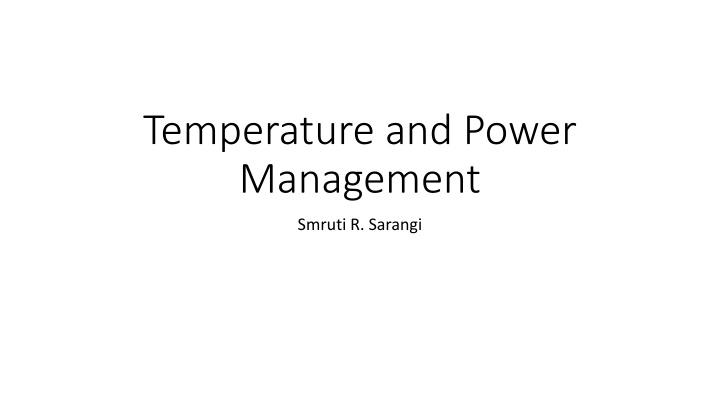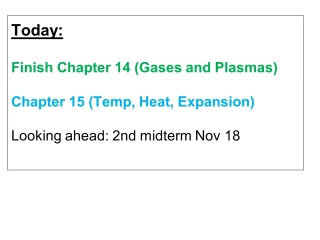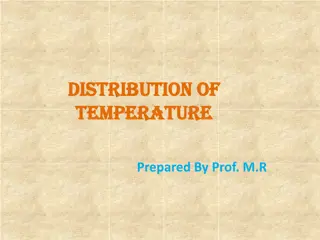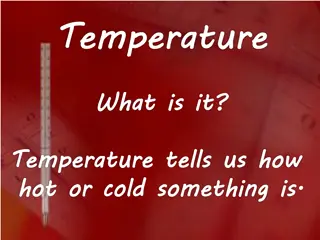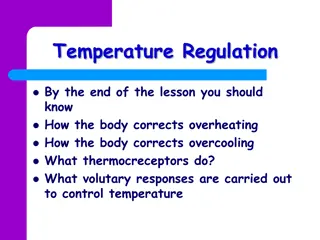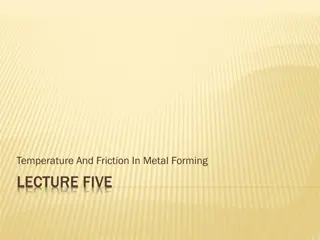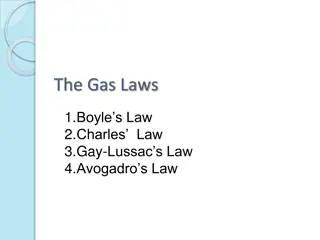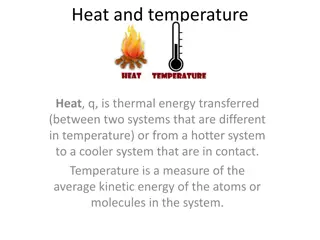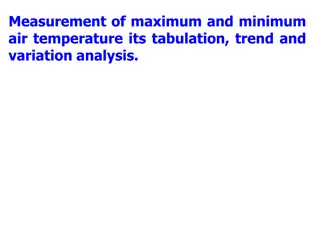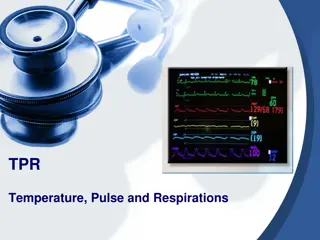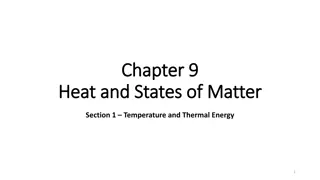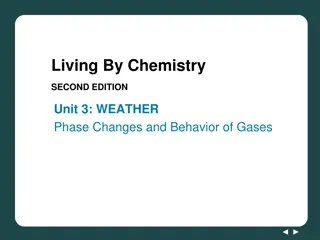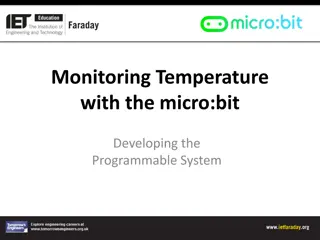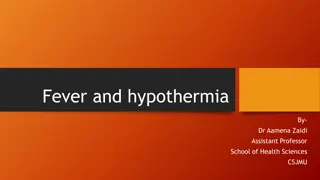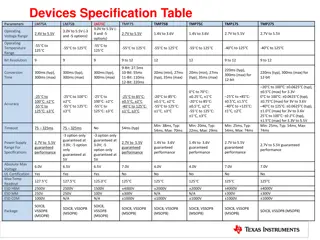Temperature and Power Management
This content delves into various techniques for managing temperature and power in electronic devices, focusing on aspects such as dynamic power management, DVFS scaling, hardware-based DVFS, and software-based DVFS. It covers topics like clock gating, voltage regulation, frequency control systems, and how to estimate CPU activity to optimize performance. The methods discussed aim to reduce power consumption while maintaining optimal device functionality.
Download Presentation

Please find below an Image/Link to download the presentation.
The content on the website is provided AS IS for your information and personal use only. It may not be sold, licensed, or shared on other websites without obtaining consent from the author.If you encounter any issues during the download, it is possible that the publisher has removed the file from their server.
You are allowed to download the files provided on this website for personal or commercial use, subject to the condition that they are used lawfully. All files are the property of their respective owners.
The content on the website is provided AS IS for your information and personal use only. It may not be sold, licensed, or shared on other websites without obtaining consent from the author.
E N D
Presentation Transcript
Temperature and Power Management Smruti R. Sarangi
Outline Dynamic Power Management DVFS Clock gating big.LITTLE approach Fetch throttling Leakage Power Management Temperature Reduction
DVFS Scaling DVFS is one of the the most popular method of reducing power in processors. Every processor has a DVFS table: Pairs of: voltage and frequency It is possible to choose one among several discrete DVFS settings Internal Operation The processor gets cues from software (user or OS) regarding changing the DVFS settings The processor also might decide on its own
Chips Power Grid and Frequency Control System 3.3V 0.8-1.2V Voltage Regulator Power Supply Chip Quartz clock PLLs The quartz clock generates a fixed 133 MHz signal PLL phase locked loop It helps generate a clock signal that is synchronized with the quartz clock The frequency is a multiple of 133 MHz For example, we can use it to generate a frequency of 133MHz * 16 = 2.13 GHz The PLL takes 10s of micro-seconds to lock to a new frequency. During that time there is no usable clock signal.
Changing Voltage and Frequency frequency PLL lock time PLL lock time Voltage V1 V0 Voltage conversion Voltage conversion
Hardware based DVFS Estimate the amount of CPU activity If it is low reduce the frequency If it is high increase the frequency (if you need performance) Estimating CPU activity Average L2 misses per instruction Commit(retirement) rate We essentially need a model to correlate frequency and performance Option 1: Get it by profiling. Run small phases of the program, and record the IPC. Option 2: Method of stall rates: assumes that the stall cycles due to LLC misses is proportional to the frequency. Decrease the frequency till the LLC miss stalls are below a certain threshold.
Software based DVFS 1) Each frame needs to be processed in 33 ms 2) If we can do it in 20 ms 3) Reduce the frequency till we process it in 33 ms 4) Need a model to relate processing time and frequency Video Codecs Regular programs 1) Classify them: hard real time, soft real time, interactive, periodic, batch 2) Real time tasks set DVFS settings based on performance and deadlines 3) Interactive Take the user s perception into account 4) Periodic jobs Take the periodicity into account 5) Batch Take the user s requirements into account
Linux Speed Governors Use the cpufreq utility Performance maximum possible frequency Powersave always run at minimum frequency Ondemand Tries to maintain a constant rate of CPU utilization. Uses a set of thresholds for each DVFS setting. Conservative Much more conservative than ondemand Interactive Similar to Ondemand, but does not use thresholds. Uses a formula that relates CPU utilization to frequency.
Clock Gating Recall Dynamic power is only consumed during a transition. Block 16 Block 1 4 3 31 30 29 2 1 32 G,P 30-29 G,P 4-3 G,P 2-1 G,P 32-31 Carry lookahead adder G,P 32-29 G,P 4-1 G,P 32-25 G,P 8-1 G,P 24-17 G,P 16-9 1. Assume bit #4 changes 2. Only the small part of the circuit shown in red is affected 3. The rest of the elements do not dissipate any dnamic power G,P 32-17 G,P 16-1 G,P 32-1
Typical Structure of a Circuit clock Pipeline Register Pipeline Register Logic What if the clock signal is 0? The output of the registers do not change There are no state transitions in the logic No current flow and thus no dynamic power dissipation
Circuit with clock gating clock S Pipeline Register Pipeline Register Logic If S = 0, the inputs to the logic circuit don t change. The circuit is clock gated. If S = 1, normal operation
Clock Gating Present in almost all architectures Guess/predict/deduce if a unit is off For example, an add instruction will not use the divider Clock-gate the divider Note that the divider will still have leakage In processors such as Pentium 4 They try to ensure that there is absolutely no deviation in timing by enabling clock gating Some times, we can aggressively clock gate. Instructions will have to wait till the unit is enabled.
Other Architectural Techniques ARM big.LITTLE Architecture, or Samsung s dual quad processor Have N big cores, and M small cores Depending on the nature of the task and its priority, choose: a big core if it is important a little core if it is not important, and power needs to be saved. Fetch throttling Dynamically adjust the fetch/issue/commit rate Based on power constraints Idea 1: After fetching low-confidence branches, reduce the fetch rate (decreases the number of potential wrong-path instructions) Idea 2: Reduce the fetch rate in the shadow of an L2 miss
Outline Dynamic Power Management DVFS Clock gating big.LITTLE approach Fetch throttling Leakage Power Management Temperature Reduction
Power Gating Brute force method: Just turn off the power Easier said than done Power Grid Power controllers Functional Unit Need to have power switches at each connection to the power grid
Multiple Transistor Sizes Transistors with shorter channels and transistors with longer channels Normal transistors: power 1 unit, time 1 unit Longer channel transistors: power 0.3 units, time 1.1 units Use normal transistors on the critical path, and slower transistors off the critical path Gate sizing Delay ? ? + ?/? , Power ? Slower transistors: smaller W/L ratio Same idea: Slower transistors off the critical path, Faster transistors on the critical path.
Adaptive Body Biasing Vth= Vth1 K1 Vdd K2 Vbs Forward body biasing Increase Vbs Reduce Vth Increase power, increase performance Reverse body biasing Decrease Vbs (even ve) Increase Vth Decrease power, decrease performance Same idea: forward body biasing in the critical path, reverse body biasing off the critical path
Drowsy Caches drowsy mode Maintain the value, accesses not allowed Allows read/writes Vdd = 0.3 V Vdd = 1V row of SRAM cells row of SRAM cells Drowsy mode Runs at 0.3 V. Maintains the value. Access it not allowed Takes 1-2 cycles to enter/exit drowsy mode Treat a set of lines as 1 unit Turn it on/off as 1 unit Once a set is turned on Keep it on 1000-2000 cycles Take temporal and spatial locality into account
Outline Dynamic Power Management DVFS Clock gating big.LITTLE approach Fetch throttling Leakage Power Management Temperature Reduction
Dynamic Thermal Management Place thermal sensors all over the chip Once a temperature hot-spot forms Traditional mechanisms: DVFS, power reduction, fetch throttling Many new techniques for CMP (multicore) processors Stop-n-go Temporarily stop a core (let it cool down) Heat and run thread assignment Don t allow hot cores to be close to each other If a thread s activity increases, migrate it to a colder region of the chip
